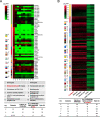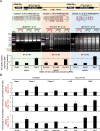Exploration of the regulatory relationship between KRAB-Zfp clusters and their target transposable elements via a gene editing strategy at the cluster specific linker-associated sequences by CRISPR-Cas9
- PMID: 36357895
- PMCID: PMC9647903
- DOI: 10.1186/s13100-022-00279-x
Exploration of the regulatory relationship between KRAB-Zfp clusters and their target transposable elements via a gene editing strategy at the cluster specific linker-associated sequences by CRISPR-Cas9
Abstract
Background: Krüppel Associated Box-containing Zinc Finger Proteins (KRAB-ZFPs), representing the largest superfamily of transcription factors in mammals, are predicted to primarily target and repress transposable elements (TEs). It is challenging to dissect the distinct functions of these transcription regulators due to their sequence similarity and diversity, and also the complicated repetitiveness of their targeting TE sequences.
Results: Mouse KRAB-Zfps are mainly organized into clusters genomewide. In this study, we revealed that the intra-cluster members had a close evolutionary relationship, and a similar preference for zinc finger (ZnF) usage. KRAB-Zfps were expressed in a cell type- or tissue type specific manner and they tended to be actively transcribed together with other cluster members. Further sequence analyses pointed out the linker sequences in between ZnFs were conserved, and meanwhile had distinct cluster specificity. Based on these unique characteristics of KRAB-Zfp clusters, sgRNAs were designed to edit cluster-specific linkers to abolish the functions of the targeted cluster(s). Using mouse embryonic stem cells (mESC) as a model, we screened and obtained a series of sgRNAs targeting various highly expressed KRAB-Zfp clusters. The effectiveness of sgRNAs were verified in a reporter assay exclusively developed for multi-target sgRNAs and further confirmed by PCR-based analyses. Using mESC cell lines inducibly expressing Cas9 and these sgRNAs, we found that editing different KRAB-Zfp clusters resulted in the transcriptional changes of distinct categories of TEs.
Conclusions: Collectively, the intrinsic sequence correlations of intra-cluster KRAB-Zfp members discovered in this study suggest that the conserved cluster specific linkers played crucial roles in diversifying the tandem ZnF array and the related target specificity of KRAB-Zfps during clusters' evolution. On this basis, an effective CRISPR-Cas9 based approach against the linker sequences is developed and verified for rapidly editing KRAB-Zfp clusters to identify the regulatory correlation between the cluster members and their potential TE targets.
Keywords: CRISPR-Cas9; KRAB-Zfp cluster; Linker sequence; Transposable elements.
© 2022. The Author(s).
Conflict of interest statement
Yang Zhang, Fei He, Yanning Zhang, Qian Dai, Qintong Li, Jing Nan, Ruidong Miao, and Bo Cheng declare that there is no competing interest regarding the publication of this article.
Figures





Similar articles
-
KRAB-zinc finger protein gene expansion in response to active retrotransposons in the murine lineage.Elife. 2020 Jun 1;9:e56337. doi: 10.7554/eLife.56337. Elife. 2020. PMID: 32479262 Free PMC article.
-
Spotting the enemy within: Targeted silencing of foreign DNA in mammalian genomes by the Krüppel-associated box zinc finger protein family.Mob DNA. 2015 Oct 2;6:17. doi: 10.1186/s13100-015-0050-8. eCollection 2015. Mob DNA. 2015. PMID: 26435754 Free PMC article. Review.
-
KRAB zinc finger proteins.Development. 2017 Aug 1;144(15):2719-2729. doi: 10.1242/dev.132605. Development. 2017. PMID: 28765213 Free PMC article. Review.
-
The Role of KRAB-ZFPs in Transposable Element Repression and Mammalian Evolution.Trends Genet. 2017 Nov;33(11):871-881. doi: 10.1016/j.tig.2017.08.006. Epub 2017 Sep 19. Trends Genet. 2017. PMID: 28935117 Free PMC article. Review.
-
Landscape of evolutionary arms races between transposable elements and KRAB-ZFP family.Sci Rep. 2024 Oct 7;14(1):23358. doi: 10.1038/s41598-024-73752-7. Sci Rep. 2024. PMID: 39375372 Free PMC article.
Cited by
-
Jack of all trades versus master of one: how generalist versus specialist strategies of transposable elements relate to their horizontal transfer between lineages.Curr Opin Genet Dev. 2023 Aug;81:102080. doi: 10.1016/j.gde.2023.102080. Epub 2023 Jul 15. Curr Opin Genet Dev. 2023. PMID: 37459818 Free PMC article. Review.
-
Multifaceted role of TRIM28 in health and disease.MedComm (2020). 2024 Nov 11;5(11):e790. doi: 10.1002/mco2.790. eCollection 2024 Nov. MedComm (2020). 2024. PMID: 39534556 Free PMC article. Review.
-
Systematic single-cell analysis reveals dynamic control of transposable element activity orchestrating the endothelial-to-hematopoietic transition.BMC Biol. 2024 Jun 27;22(1):143. doi: 10.1186/s12915-024-01939-5. BMC Biol. 2024. PMID: 38937802 Free PMC article.
References
-
- Imbeault M, Helleboid PY, Trono D. KRAB zinc-finger proteins contribute to the evolution of gene regulatory networks. Nature. 2017;543(7646):550–554. - PubMed
LinkOut - more resources
Full Text Sources
Research Materials

